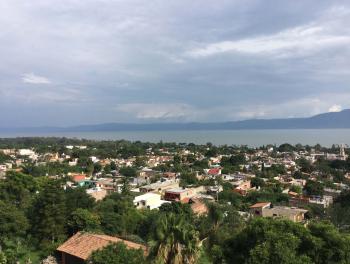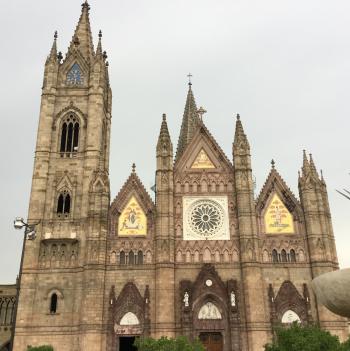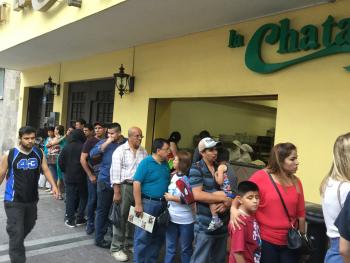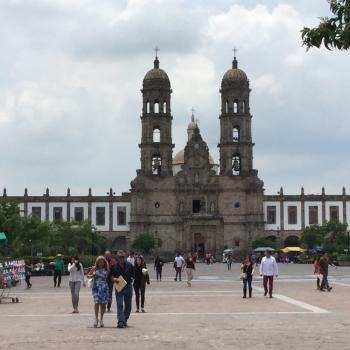A 10-day trip for less than $1,000? Guadalajara, Mexico, meets the challenge
This article appears on page 44 of the June 2017 issue.
In April 2016, I retired from my job of 15 years. My friend Jessica had retired a few months before. Like me, she has a passion for travel.
I told her that I could plan an international trip for 10 days for less than $1,000 each, all inclusive, and I challenged her to see if she could do the same. She had doubts but felt it was worth looking into.
To save travel time, we looked only at destinations with nonstop service from Los Angeles. After some searching, she and I settled on Guadalajara, Mexico. We decided four days would be enough time for Guadalajara, so we added the Lake Chapala area and the city of Tequila to our itinerary.
A third friend, Chris, decided to join us as well.
Making plans
My online research revealed that Guadalajara had many things to offer, such as grand cathedrals, a huge main square and reasonably priced hotels, along with pottery and other handicrafts. At an elevation of 5,100 feet, the city doesn’t get extremely hot or cold, but July, when we planned to visit, is one of the wettest months of the year. The three of us decided, however, that nothing would stop us from having fun, not even torrential rain. (As it turned out, we actually had rain only four times, three of those in the afternoon and only briefly.)
Our flight on Volaris ($320 per person, including seat assignments and one carry-on bag each) departed three hours late from Los Angeles. Arriving in Guadalajara after dark, we decided it was not safe to look for a bus to the city center, so we opted for a taxi (320 pesos, or $17) to our hostel, Casa Vilasanta (Rayón 170), which was within walking distance of the historic district.
We had reserved two rooms for a total cost of $269 for five nights, which included a simple breakfast of fruit (papayas, pineapples and cantaloupes) as well as dry cereal and oatmeal. Tea and coffee were available, but we had to boil our own water. We also had to wash our dishes.
Guadalajara
Our plan for the first day was to visit the historic district. During the trip-planning stage, I had printed two different self-guided walking tours to use as a guide, but I didn’t use them at all. Instead, I used two free apps my sister-in-law told me about: MAPS.ME, for local maps, and Yandex (translate.yandex.com), for language translation.
I downloaded the apps onto my iPad, then downloaded a map of Guadalajara. I found all the sites on the map that we wished to visit and saved their locations in red. As we walked from one place to another, MAPS.ME tracked our movements, so we knew when we were closing in on our destinations. I also saved the location of our hostel so we could find our way back.
In Centro Histórico, there were signs in Spanish and English marking the directions to different sites. In front of each was a sign describing the attraction. Among the places visited was the beautiful neo-Gothic Templo Expiatorio del Santísimo Sacramento. This cathedral was only two blocks from our hostel, so we visited during the day and at night.
We also wanted to spend a day in the suburbs of Tlaquepaque and Tonalá, but we didn’t have a clue how to get there. We stopped by the tourism kiosk in Plaza de la Liberación and were told that there was a double-decker hop-on/hop-off bus that went there.
In fact, there were three lines; one went to Tlaquepaque, and from there we could connect to the line that went to Tonalá. The third line traveled around the Centro Histórico and the west side of the city. We could travel on all three lines for 140 pesos each. (For seniors 60 and over, the price was MXN90.)
On our second day in the city, we took the hop-on/hop-off bus that left promptly at 9:40 a.m. from in front of the Rotonda. Announcements of the various stops were in Spanish only.
After 40 minutes, we arrived at Tlaquepaque, a small town with essentially two main streets, one of which was pedestrian-only. After spending about two hours exploring, then having a simple lunch, we left for Tonalá on another bus.
Tonalá is known for its craft-and-souvenir market. This ad hoc, temporary market reminded me of a swap meet or a farmers’ market.
There was a narrow walkway and, on either side, shop after shop offering souvenirs and crafts of every kind. The prices were so economical compared with similar things I’d seen in Europe.
Our intended 20-minute stay turned into two hours. It was fascinating to see so many things all in one place. We didn’t even reach the end of the market before it was time to catch the bus back to Guadalajara.
Zapopan
According to Wikitravel.org, the suburb of Zapopan has a small-town atmosphere and is home to the Mercado del Mar, where fresh seafood can be found. Since we are seafood lovers, this sounded like a great place to spend a day.
At the tourist kiosk, we learned that, due to construction of the subway, getting there would not be easy. Not wanting to take a taxi, I told my friends to keep an eye on any bus that passed as we walked around the Centro Histórico to see if they could spot “Zapopan,” or “Mercado del Mar” posted on any.
By chance, we saw a bus (No. 633) stopping at a traffic light, and on top it displayed “Zapopan, Mercado del Mar No. 633.” So we took the next No. 633 bus and asked the driver to tell us when we reached Mercado del Mar. The cost was 7 pesos per person.
We found the Mercado del Mar easily with the help of MAPS.ME and had a delicious lunch of langoustines and crabs for a total of around $22 at El Zarandeao. Afterward, we walked to the small town center, where there was a huge church with a plaza in front of it.
A day at the zoo
On our last day in Guadalajara, we decided to venture north of the city. We took the Macrobús all the way to the north end of the city (7 pesos), then it was a 10-minute walk to the Parque Mirador, with a view of the canyon. The day was hazy, but we could see the river below. Then we walked two bus stops south to visit the zoo (entry, MXN110 per person).
It was quite warm and humid, so we bought flavored crushed ice and sat on the low concrete wall facing the giraffe enclosure. In the distance were four giraffes.
After about 10 minutes, one of the giraffes sauntered over and started snuggling up to Jessica. There were two young zoo attendants to keep us safe during the experience.
The giraffe kind of nipped at her calf for a few minutes, then turned her head toward me and did the same. In my few visits to zoos, I had never had a giraffe come so close to me!
Walking through Centro Histórico to get back to our hostel, we decided to stop for a bite at La Chata. The day before, we had seen people lined up out front, so we wanted to find out why.
We ordered three items, pozole blanco con pollo (a soup), the “plato combinado” and enchiladas de pollo con mole, to share. The food was delicious and worth the wait.
To the lake
After four adventurous days in Guadalajara, it was time to say good-bye. We took an Uber to the airport ($9.34) for our flight to the Lake Chapala region. The driver was a happy mother with an exuberant personality who talked the whole way, using the translator on her phone. (There were so many Uber drivers in the city that within three minutes of our requesting a ride, the driver was at the pickup point.)
Before leaving home, we had reserved a car from Fox Rent A Car for $40 for our 5-day stay near Lake Chapala. We couldn’t believe how inexpensive it was, but when we arrived to pick up the car at the airport, the agent refused to rent it to us without our buying CDW and additional liability coverage. (Basic liability is covered in Mexico.)
We had with us a letter from my MasterCard company, Citi ThankYou Premier MasterCard, saying that the rental car would be covered for CDW, but the agent said that if the rental car was damaged, Citi would not send a claims adjuster to assess the damage. The lowest cost for the rental would be $180 for five days.
Since ground transportation was really inexpensive in Mexico and $180 was a lot of money for us, we decided to forget about renting a car. We took an Uber instead. The ride from the airport to our hotel cost MXN170 ($9).
We arrived at Casa Luz (Colon 100), in San Antonio Tlayacapan, in about 40 minutes. Our 3-night stay cost $354 for two rooms and included daily breakfast of yogurt, scrambled eggs, toast and tea or coffee.
Thomas and Luz welcomed us into their casa like old friends, and Thomas gave us directions to a church in nearby Ajijic where we could get a great view of the lake.
All the cities along the shore of Lake Chapala had narrow sidewalks and roads paved with black rocks of different sizes that made walking difficult.
On our second day in Lake Chapala, we decided to visit Mezcala Island. We took a bus heading east from San Antonio Tlayacapan (9 pesos each) to the city of Chapala. From there, we took another bus to the town of Mezcala (16 pesos each). The ride was quite scenic, following the coastline part of the way.
A young man soon approached us and offered to take us to Mezcala Island and back for 300 pesos. After making sure he had life jackets (none of us knew how to swim), we agreed. We were the only passengers for the 20-minute ride.
One of the island’s main sites is a fort built by the Spanish in 1819. There were signs in Spanish and English describing each attraction. After we arrived on the island, a local boy approached us offering to show us around. We declined, but, in retrospect, maybe we should have paid him a few pesos to tell us about the fort.
We spent an hour there before heading back to town.
On to Tequila
After a final day in the lake area, we traveled to the city of Tequila to visit the distilleries there. We took an express bus back to Guadalajara (MXN50). The bus was packed with people, but after 10 minutes quite a few got off, freeing up seats.
It took exactly one hour to arrive at the station near Guadalajara’s Centro Histórico, Antigua Central Camionera. From there, a kind woman we met on the bus walked us to the Tequila Express ticket booth to ask, in Spanish, about the prices for single (MXN85) and round-trip (MXN140) tickets and the bus’ time schedule. She made sure we had all our questions answered before she left. Her assistance was typical of the Mexicans we met during our trip, who were always nice and always helpful.
While we were waiting for the bus to Tequila, we met a lady from Chiapas who spoke fluent English. When we arrived in Tequila two hours later, she helped us get directions to the central historical area.
On the way there, we were stopped by Ricardo Romero of Tequilitas Tours. He also spoke fluent English, and he had a brochure explaining all the tours his company offered. The total cost for a city tour (which wasn’t much of a tour) plus visits to two distilleries was MXN200 per person.
Our first distillery stop was Tequila Orendain. We walked from the area where agave plants were mashed and boiled, then to the fermentation tanks and on to the oak barrels used for aging the tequila.
We learned that they produced three grades of tequila: blanco, which is just distilled, añejo, aged in oak barrels for one to three years, and extra añejo, aged for more than three years. Typically, the longer the aging process, the more expensive the tequila is.
Ricardo then took us to the second distillery, Casa Sauza. The tour there was more extensive and offered more detail. We all had to wear hard hats and orange vests.
After the tour, we had at least six tastings, and we ended in a gift shop, where we could purchase tequilas not sold in the duty-free shops at the airport.
While in Tequila, we stayed at Hotel Plaza Jardìn (Calle José Cuervo 13), paying about $62 for two rooms for two nights. The hotel was only a few feet from the main cathedral, which was close to everything. (The next morning at around 5, and every 30 minutes, the bell from the cathedral rang so loud it was like I was sitting right next to it!)
Back to the beginning
We returned to Guadalajara by bus the next morning. As we reached the city limits, I could see on MAPS.ME where we were headed.
We soon arrived at Hostel Refugio, where we had reservations, but the owners, a husband and wife, were surprised to see us. They asked us to wait, and we waited for well over an hour and a half.
Later we found out that the husband, Gustav, had emailed me around 10:30 a.m. and asked us to confirm our reservation before 3 p.m. I had seen the email but didn’t open it. So when we arrived at 4:15, our rooms had already been given to someone else.
Gustav made some phone calls, then he drove away to look for similar lodging. He finally found a place for us a couple of miles away and drove us there. It actually turned out to be a better place to stay. Our new lodging, in somebody’s house, cost about $45 for two rooms for one night.
We were quite impressed with the attitude of Gustav. He even walked with me to find an ATM, and he was so positive and good-natured.
The next morning, we took an Uber to the airport. The driver, a college student, arrived in less than 30 seconds. He said he was studying to be an opera singer, and he sang us a few lines — quite entertaining. The ride during Friday-morning rush hour cost $12.
Having reached the end of our trip, we tallied up how much we had spent on our 10-day visit, and, at $774 per person, we were well under our $1,000 goal. We each had several hundred pesos left because we had spent different amounts on souvenirs.
This trip, my second visit to Mexico, reconfirmed that it is a nice place to visit. The weather was not very hot during our stay. Guadalajara’s Centro Histórico, with its many pedestrian-only streets, was great for casual strolls and people-watching. The towns along Lake Chapala were great for relaxation.
There was so much to see, smell, absorb and experience, and the people were so friendly and helpful.
We all left Mexico with a wonderful impression of this beautiful country, and we would love to return again to explore all the places we haven’t seen yet.




